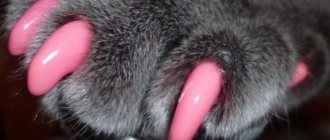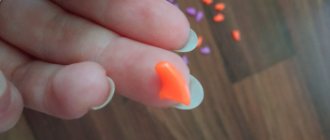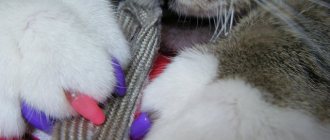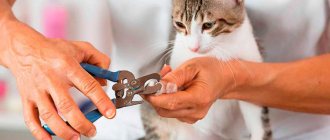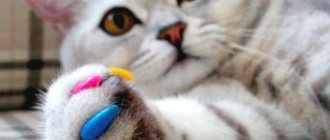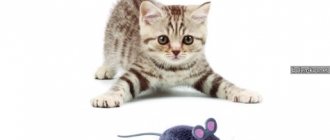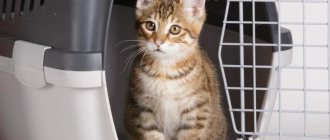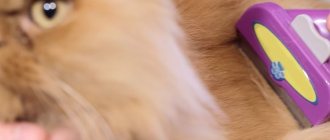Anti-scratch guards for cats are designed to protect surrounding objects and household members from the sharp claws of a pet. Popular silicone pads come in 4 sizes and can be used on kittens from 4 months of age (size XS for babies). To fix them, a special glue is used, which is included in the kit and does not cause allergies.
The service life of the covers is 1-1.5 months. It is not allowed to be worn for up to 4 months, if you are allergic to glue and for animals that walk outside, if there is a fungus or infection on the claws. On average, for a set of 40 nozzles you will have to pay up to 400 rubles.
An alternative to anti-scratch treatments can be a repeller spray (Beaphar Stop-it Cat, Biovax, Anti-scratch) and training the cat to use a scratching post.
What are anti-scratch products for cats?
Anti-scratchers for cats are silicone, rubber or plastic attachments. The useful accessory was invented as an alternative to onychectomy - a bloody operation to surgically remove a claw and part of a pet's finger. A wide selection of pet products allows you to choose anti-scratch products not only by type of material, but also by the size of your pet, and even by color.
Can it be used for kittens from 2 months of age?
Veterinary experts do not recommend using protective covers for kittens over 2 months old. Manufactured products, even of the smallest size, do not fit well on children. Curious pets can easily pick them off and swallow them. Anti-scratch products can be used starting from 4-5 months of age for a kitten. For these purposes, the smallest attachments in size XS are produced.
When you do and don't need claw protection for cats
You can use cat claw protection in the following situations:
- The animal is not accustomed to using a scratching post and damages furniture, walls, and foreign objects.
- There are small children in the house, and the pet is not always peaceful when it comes to children's games.
- Aggressive and evil character of the cat.
- Prevention of scratching when your pet is infected with fleas, develops allergies and other dermatological problems.
- The owner has health problems. Scratches from pets can cause allergies and are unsafe for bleeding disorders.
You should not use nail guards if:
- The animal has an individual intolerance to the material from which the accessory is made.
- The pet has free access to the street. A cat needs claws not only to climb trees, but also to protect itself from dogs and aggressive relatives.
- The main task of a cat is to hunt mice. The use of anti-scratches in this situation will negate all the hunting abilities of the animal.
Popular manufacturers
Yami-Yami scratching post
The scratching post is made in the style of a hut with a post. Made from artificial fur and carpet. The winding is made of jute fiber. Approximate weight: 5.6 kg. The average cost is 1,495 rubles.
ADVANTAGES:
- appearance
- availability of a house
- variety of colors
- easy to assemble and disassemble
- assembly key included
FLAWS
not detected
Yami-Yami scratching post
Kitty City scratching post
The product includes interactive entertainment and can also be used horizontally and vertically. The material is high-strength sisal that can withstand the diligent efforts of your pet. Suitable for individual use, as well as in tandem with other complexes. Price – 1,000 rub.
ADVANTAGES:
- price
- presence of ball toys with bells
- Can be used in horizontal and vertical positions
- can be used with other Kitty City play complexes
FLAWS
- not very stable design
- claws don't grip well
Kitty City scratching post
Homecat corner scratching post
The Homecat scratching post will distract your cat from loneliness and fit perfectly into the interior. Material: high quality carpet. Includes: mint to attract attention. Cost – 325 rubles.
ADVANTAGES:
- price
- good quality carpet
- Includes a bag of catnip
- doesn't take up much space
FLAWS
not detected
Homecat corner scratching post
Scratching post TRIXIE
A convenient device made of high quality materials. The range offers a variety of sizes as your pet grows and needs the right item. Contents: bolt, two screws. Color – beige, material – sisal. Price – 1,070 rubles.
ADVANTAGES:
- nice appearance
- presence of a ball toy
- high quality braid material
FLAWS
the structure is not very stable
Scratching post TRIXIE
"Cottage" Benelux
The house with an unusual design incorporates all the best and most comfortable things for a four-legged friend. Mounted on 3 scratching posts, firmly mounted on a platform made of faux fur. The play set is made of sisal. Price – from 8,450 rubles.
ADVANTAGES:
- attractive appearance
- structural stability
- strength of materials
- availability of toys with bells
FLAWS
somewhat inflated price tag
Benelux Scratching Post
MAJOR Wave
Ideal for a pet. The design and compact size will fit well into the interior of the house. The complex will allow you to keep the furniture in its original form and amuse the cat. Includes: bag of mint. Material: sisal and plush. Cost – 1,730 rubles.
ADVANTAGES:
- nice appearance
- sustainability
- good quality plush and sisal
- Includes a bag of catnip
FLAWS
not detected
Major Foxie Wave
scratching post post
The product is made of high-quality materials, it optimally correlates the criteria of height and width. The round base is securely fixed and comfortable for the cat; it will not move due to movements. The average price is 680 rubles.
ADVANTAGES:
- price
- sustainability
- compactness
- rope with ball firmly attached
FLAWS
some cat owners considered the quality of the winding to be poor: the ropes come off and crumble
Homecat Scratching post
Features of using claw pads for cats
Claw pads for cats have the following features:
- the size of the covers should be chosen taking into account the weight of the animal;
- Anti-scratch pads should only be glued with the special glue included in the kit;
- It is not necessary to put tips on all the claws; you can “disarm” only the front paws.
Pros and cons, possible complications of declawing protection for cats
Claw protection for cats has its advantages:
- cases allow you to protect valuables from damage;
- in case of a skin disease accompanied by itching, scratching is prevented;
- facilitate bathing and other hygienic or medical procedures for an obstinate cat;
- do not harm the pet;
- the covers can be put on the claws yourself;
- are inexpensive.
Anti-scratch pads also have their disadvantages:
- independent care of hair and ears becomes impossible;
- a cat with access to the street may become a victim of aggressive relatives or dogs;
- The animal cannot cope with the task of a mouser.
Myths about nail caps
Many myths about nail caps have not been confirmed:
- Myth No. 1. The devices prevent the animal from walking. Correctly sized and applied silicone pads do not affect the pet's gait. At first, out of habit, the cat may move uncertainly, but soon its former grace returns.
- Myth No. 2 . A cat cannot retract its claws if they are covered with covers. If the instructions are followed, the soft caps cover only 2/3 of the length of the claw and do not prevent their retraction.
- Myth No. 3 . Anti-scratch products are harmful to health. Properly selected and worn covers are safe for the cat. In rare cases, the adhesive used to secure them can cause an allergic reaction.
Cat's reaction to nail covers
When using claw covers for the first time, the cat’s reaction can be very negative: some cats try to get rid of an unknown object using their teeth. However, the durable material from which the device is made protects it from furry vandals.
The cat's gait may change. As a rule, animals quickly get used to the presence of caps on their nails and after a day or two they completely forget about their existence.
In rare cases, some pets may develop an allergic reaction to the material from which the protective accessory is made.
Are anti-scratch guards harmful to cats and who should not wear them?
The opinion that anti-scratch products are harmful for cats in most cases is due to their illiterate use. Over many years of foreign practice, no cases of threat to animal health have been identified when used correctly.
You cannot put attachments on the claws of cats that have access to the street and in case of individual intolerance to the material. The minimum age for kittens to use anti-scratch products is 4 months.
Reviews from veterinarians
Reviews from veterinarians about anti-scratch products are in most cases positive. If the owner follows the instructions for their use, experts consider this invention safe for the health of the animal. Some veterinarians have expressed the opinion that false nails prevent the cat from realizing its natural instincts and make grooming more difficult.
Benefits of caps
Manufacturers of claw pads never tire of praising their products, promising that they will forever get rid of many problems caused by cat claws.
Advantages of “soft claws”:
- replace brutal amputation of claws (along with digital phalanges);
- do not interfere with the natural growth of claws;
- suitable for animals of different ages (effective and safe);
- protect furniture upholstery/wallpaper from damage;
- protect children's skin from scratches;
- protect the cats themselves, especially hairless ones, from accidental injury from the claws of their hind paws;
- used for yard animals temporarily taken into the house;
- easy to use, the result lasts 6-8 weeks.
Owners who have failed to train their cats to use anti-scratch pads are convinced that claw covers should be used very rarely and for a short period of time.
Types of nail tips
Nail tips come in different types: silicone, rubber and plastic. A variety of colors has a practical meaning - the owner can see if the cover is lost, and it is convenient to find it in the room.
Advantages of using silicone pads
Silicone pads are the most popular among owners, since the material rarely causes allergies, adheres well and does not hinder the natural movements of the animal.
How to make anti-scratch for a cat with your own hands
If desired, the owner can make anti-scratch bars for a cat on his own, using silicone and polypropylene.
From what age can it be used?
Manufacturers produce anti-scratch pads in various sizes, so you can find suitable pads even for a one-month-old kitten. However, veterinarians do not recommend using this device until 6 months of age, because this is the period of vigorous development of the kitten, the peak of its motor activity, when the claws wear down naturally during play. In addition, until the age of six months, the animal’s claws are still too soft.
Did you know? Cats can, to a certain extent, be equated to ballerinas - these graceful, graceful predators are a digitigrade species and only step on their toes when moving.
How to put on your cat's nails
You should put false nails on your cat after the claws have been trimmed. If separation of the stratum corneum is observed, then it is necessary to trim the surface with a file.
How to properly glue a cat's nails
The following instructions will help you glue your cat’s nails correctly:
- prepare 5 silicone caps from the package;
- apply a small amount of glue into the cavity of the nozzle (no more than 1/3 of the volume);
- disinfect the claws on the cat’s paw with an antiseptic;
- Having pressed on the crumb, extend the claw and place the cap on it, gently pressing it on all sides;
- similarly glue attachments to all the pet’s claws;
- when the anti-scratch for the cat is glued, the animal should be held so that the glue sets, and after 10-15 minutes the cat with false nails can be released;
- Glue from the owner's fingers can be removed with nail polish remover.
If the pet is mischievous and breaks out, then you can attract an assistant and wrap the cat in a blanket for the procedure.
Anti-scratch for cats: instructions on how to use
There are no special instructions for using anti-scratch pads for cats; the animal simply wears them until they either rip them off or they fall off along with the renewal of the nail. If your pet chews and eats the cover, it’s okay. It will come out naturally without damaging the walls of the stomach and intestines.
Anti-scratch glue
Glue is included with the cases. A non-toxic product is used to attach silicone tips. In rare cases, the glue used to attach false nails can cause an allergy in your cat.
How to remove anti-scratch pads from a cat's claws
You can remove scratch guards from your cat’s claws when the stratum corneum of the claw grows back. In this case, the nozzle disappears on its own. This happens after about 1-2 months, depending on the intensity of the natural processes of claw regrowth in the cat.
If you need to remove them a little earlier, then you need to carefully trim the tip of the cover and pull it off.
Advice from veterinarians
We are already familiar with veterinarians’ reviews of anti-scratch products for cats. Let's see what doctors advise if you decide to “shod” your cat in silicone caps:
- Anti-scratch pads can only be applied to a healthy pet. Inspect the paws: if there are traces of fungal diseases on the claws, and there are wounds or irritation on the pads and between the toes, be sure to abandon your idea.
- It is possible that harmful microorganisms may accumulate inside the anti-scratch product. Therefore, regularly examine your cat’s paws for signs of inflammation and fungus. If you notice anything you don't understand, don't put off visiting your veterinarian.
- Apply the pads very carefully - do not let the glue get on the cat's pads. It tightens the delicate skin, leading to the formation of wounds and cracks where infection can easily occur.
- If silicone is a harmless substance, then even safe glue can become harmful to a cat, because the animal may have an individual intolerance to the components. If he becomes irritable, and his fingers become red or swollen, you need to urgently go to the veterinary clinic!
That's all the advantages and disadvantages of anti-scratch products identified by veterinarians and cat owners. In conclusion, we warn you: if the procedure for gluing caps on the claw is not completely clear to you, entrust it to specialists. Observe their work so you can repeat it yourself next time.
Anti-scratch alternative
An alternative to anti-scratching can be a cat repellent spray, training the animal to use a scratching post, or special socks.
Anti-scratch spray
Anti-scratch sprays contain repellent substances, such as essential oils, which furry creatures do not like. The most popular repeller sprays among owners are Beaphar Stop-it Cat, Biovax, Antiscratch (True Friend) and Antiscratch pheromones for cats.
Scratchy
A scratching post or scratching post is a device for grinding down claws in apartment living conditions. You can purchase a horizontal or vertical modification at a pet store. Most often, jute rope, sisal, and corrugated cardboard are used for its production. Some pets will like a wooden scratching post.
Getting used to using the device will not be difficult if you buy a finished product specially impregnated with aromatic agents.
High-quality treatment from specialists
We offer our visitors the highest level of modern diagnostic equipment. How to stick nails on a cat Rostov-on-Don - we have the best treatment. Patients in intensive care and hospital are under constant medical supervision. The veterinary pharmacy, located in the lobby of the clinic, sells all the necessary medications to treat your pets. Here you will find EVERYTHING without long searches and with a guarantee of high quality! If necessary, you can order delivery of medicines, food and pet accessories to your home. To transport your pet, use our pet taxi, which will take you and your pet to the veterinary clinic from anywhere in Rostov-on-Don and the region. Call us, we will be happy to answer all your questions. By asking us a question you can get a free consultation with a doctor. Rest assured, by visiting the website of our veterinary clinic, you will always be able to find an up-to-date answer to your question, be it a description of a procedure or a description of rare diseases of dogs and cats. Our veterinary clinic conducts active educational work. On our website you can read articles devoted to various aspects of the treatment and care of animals, as well as a modern view of veterinary medicine.
The simplest claw clippers - easy and fast
In a house where a cat has appeared, a scratching post for it becomes almost an essential item for the owners, if they do not want to subsequently admire damaged things. Because in her absence the cat will sharpen its claws on anything, most often furniture. And if she gets used to something, it will be quite problematic to wean her off later.
If a cat appeared in the house unexpectedly, or there is no time to create a stationary claw sharpener, then the simplest methods for making them are suitable for this case. The simplest scratching post can be a piece of soft wood log with peeled bark 70-100 cm long. A wooden scratching post is very strong, durable and does not require cleaning. You can cut a log in half along the grain and attach it to the wall.
When to change?
Along with the anti-scratch pads there are instructions that describe the removal procedure and terms of use. It is recommended to change it once every 2 months, when the animal’s upper tissue on its claws begins to renew. During this period, the caps themselves fall off due to the fact that the stratum corneum does not hold on. In addition, at first the animal will try to remove the anti-scratches on its own, so they can be re-glued. But if the pet does not experience discomfort and the expiration date of the pads has not passed, then it is not recommended to remove them, as this will injure the cat.

